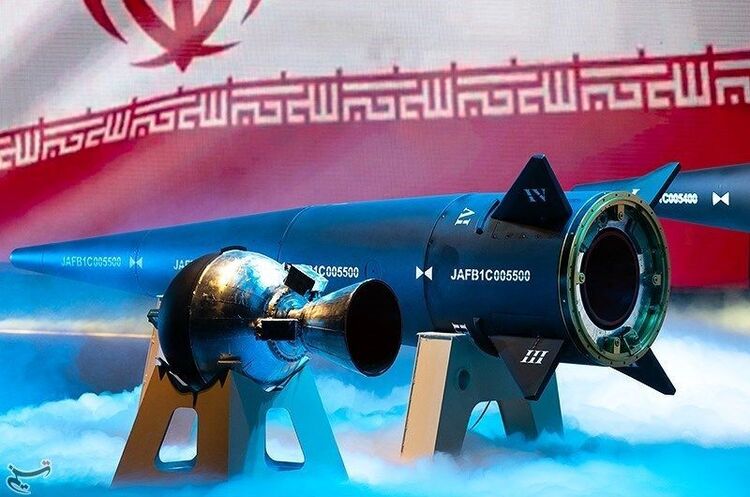Iranian Fateh: Real Threats and Myths about New Hypersonic Missiles
Spoiler: Still a Political Tool

Recently, Tehran unveiled a 'hypersonic missile' from the Fateh family, which purportedly has the ability to exceed the speed of sound by 15 times (5.1 km/s) and strike targets up to 1400 km away. The developers claim that the flight time to Tel Aviv would be only 400 seconds and that the Israeli Iron Dome system would be unable to intercept it. Military expert Mykhailo Zhyrokhov, speaking to Mind, shed light on what is known about this missile and whether it poses a threat.
Israeli Defence Minister Yoav Gallant commented on Iran's announcement, stating, "I hear our enemies boasting about the weapon they are developing. Whatever the case may be, we have an even better response – whether on land, in the air, or at sea, both defensively and offensively."
Washington, on the other hand, did not directly comment on the emergence of the hypersonic missile. However, John Kirby, the official spokesperson for the National Security Council, stated that the Biden administration had been "very… resolute in trying to get Iran to stop its destabilising activities in the region, including the development of ballistic missile improvement programmes."
Iranian Missile Development Programme – Historical Facts
However, to understand how this weaponry can pose a real threat to Israel, one needs to delve into the history of the Iranian missile development programme.
As of 2023, Iran possesses the largest and most diverse arsenal of ballistic missiles in the Middle East. The majority of these missiles have foreign origins, particularly from North Korea. Currently, the Islamic Republic is the only country to have developed a missile with a range of 2,000 kilometres without previously possessing nuclear weapons.
Although Iran still relies on foreign suppliers for some key components and equipment, Western military analysts note that it has the technical and industrial potential to develop long-range missiles, including intercontinental ballistic missiles. It is believed that Iran will not have the capability to strike the United States before 2025.
The thing is, the effectiveness of Iranian liquid-fueled ballistic missiles is limited due to their low accuracy. Therefore, these missiles are unlikely to be decisive if armed with conventional, chemical, or biological warheads. However, Tehran can use its missiles as a political or psychological weapon to terrorise enemy cities and thereby exert pressure on their government.
Why did everything go wrong?
Yes, the Fateh-110 family of solid-fuel missiles achieved the required accuracy for reliable destruction of military targets and critical infrastructure objects, as demonstrated during the attack on American forces stationed at Ayn al Asad Airbase in Iraq, using Zolfaghar missiles in January 2020.
Iran's space programme, which includes successful launches of several small satellites into low Earth orbit using Safir and Qased carrier rockets, demonstrates the country's growing ambitions and technical capabilities. Since 2016, the larger and more powerful Simorgh has failed to place a satellite into orbit during four launch attempts, and work on it continues.
Iran has sought to develop ballistic missiles even before the Islamic Revolution. Ironically, the Shah collaborated with Israel to develop a short-range system after Washington rejected his request for Lance tactical missiles. The first missile project known as Flower received funding from Iran and technology from Israel. Tehran also pursued nuclear technologies, indicating an interest in a nuclear weapons delivery system. Both programmes collapsed after the 1979 revolution.
Before the Islamic Revolution, Iran had the largest air force in the Persian Gulf, including over 400 combat aircraft. However, Iran's capabilities for conducting deep strikes quickly deteriorated after severing ties with the West, resulting in limited access to spare parts, technical support, pilot training, and modern weaponry.
Therefore, with the onset of the Iran-Iraq war, Tehran decided to compensate for this with tactical missiles. As a result, the country acquired Soviet-made R-17 Elbrus complexes (more commonly known as Scud) with a range of 300 km, initially from Libya, and later from Syria and North Korea.
Iran's Missile – Myths and Real Threats
After the war, Tehran consistently expanded its missile arsenal. It also invested significant funds in its own industries and infrastructure to reduce dependence on foreign sources. Now it is capable of producing its own missiles, although some key components still require imports. Overall, Tehran has created the potential to manufacture missiles to address a full range of strategic tasks.
However, at its core, similar to the North Korean program, lies the Scud technology. Indeed, the first series of Shahab missiles (meaning 'Meteor' in Persian) are essentially complete clones of Soviet missiles with some form of modernisation. From the Shahab-2 missile (with a range of 500 km), the Qiam program emerged, utilising a modular warhead that reduces vulnerability to anti-missile defences.
The second version of Qiam appears to be equipped with a manoeuvrable warhead to enhance accuracy. Both versions have a range of 700 to 800 km and feature warheads weighing between 500 and 600 kg. Tehran has exported Qiam missiles to the Houthi rebels in Yemen for attacks against Saudi Arabia.
Shahab-3 is based on the Nodong missile, which is a North Korean missile with a range of approximately 900 km and a warhead weighing 1000 kg. Flight tests of the modified version of Shahab-3, named Ghadr-1, began in 2004. Several variants of Ghadr-1 have emerged, each slightly modified to enhance reliability and ease of operation.
It is believed that the majority of Iranian Shahab-3 missiles have been retrofitted into Ghadr missiles, which can target distances of up to 1600 km. However, this achievement is primarily due to the reduction in warhead weight to 750 kg.
Among the other powerful missiles in Iran's arsenal are the Zolfaghar and Fateh missile families. By the way, when there was information about Tehran's plans to transfer tactical missiles to russia, it was precisely about them. These are solid-fueled missiles with a range of up to 1000 km and possibly up to 1400 km. For example, Fateh-110 flies on a trajectory that remains within the Earth's atmosphere throughout its flight.
Since the early 2010s, Iran has made a series of modifications to improve the range and accuracy of the Fateh-110. For instance, while the original Fateh-110A had a flight range of approximately 200 km, the Fateh-313 has it increased to around 500 km. Fateh-type missiles carry a payload of about 450 kg.
The Zolfaghar, Dezful, and Haj Qasem Soleimani missiles follow the same basic design principles as the Fateh systems but have slightly larger diameter missile engines, allowing for an increased flight range of approximately 700, 1000, and 1400 km, respectively. It is believed that the larger missiles have warheads weighing around 550 kg.
Missiles of Iran are currently a political tool
However, it is important to note that satellite navigation devices such as Global Positioning System (GPS) receivers, which are used in Iranian precision-guided missiles, may become less effective due to the jamming or spoofing of GPS signals.
Despite Iran prioritising the development of high-precision missiles in the 2010s, it did not neglect the work on long-range missiles. A notable example is the Khorramshahr missile, whose design is based on the North Korean medium-range ballistic missile, Hwasong-10. The latter, in turn, is a modified version of the outdated Soviet submarine-launched ballistic missile, R-27 (NATO reporting name AA-10 Alamo). Iranian officials claim that Khorramshahr has a maximum flight range of 2,000 km with a warhead weighing 1,800 kg. However, it is known that all launches of this Iranian missile so far have been unsuccessful.
In general, it is possible to say that universities and other technical centres in Iran continue to conduct fundamental and applied research to support missile and space facility development programmes.
UN Security Council Resolution 2231 prohibits Iran from engaging in activities involving "missiles capable of carrying nuclear weapons". According to a 2019 study, only the original Shahab-3 and Khorramshahr missiles were explicitly "designed as carriers of nuclear weapons".
Additionally, Iran has allocated significant resources to enhance the survivability of its ballistic missiles prior to launch by increasing mobility and expanding the network of underground bunkers and tunnels from which missiles can be launched.
Iranian liquid-fueled ballistic missiles have low accuracy. Successfully destroying a fixed military target such as an airfield or seaport would require Tehran to use a substantial number of liquid-fueled missiles.
Without a nuclear warhead, Iranian liquid-fueled ballistic missiles are more effective as a political instrument for intimidating or terrorising urban areas of the adversary, exerting pressure to resolve an issue or taking action. Such attacks can instil fear, but the likely casualties would be minimal – most likely in the hundreds, even if Tehran deploys its entire arsenal of ballistic missiles and manages to penetrate Israel's missile defence.
As for the development of a hypersonic missile, considering the current technological state of the Iranian industry, it is more akin to intimidating enemies rather than a realistic combat missile. A notable example is that even russia, with capabilities greater than Iran's, is unable to develop a functional hypersonic missile. The case of the operational use of the Kinzhal, which the kremlin considered to be such, vividly demonstrates the state of the problem.
The OpenMind authors, as a rule, are invited experts and contributors who prepare the material on request of our editors. Yet, their point of view may not coincide with that of the Mind editorial team.
However, the team is responsible for the accuracy and relevance of the opinion expressed, specifically, for fact-checking the statements and initial verification of the author.
Mind also thoroughly selects the topics and columns that can be published in the OpenMind section and processes them in line with the editorial standards.



